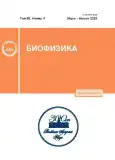Influence of the microenvironment dynamics of tryptophan on its fluorescence parameters at different temperatures
- Authors: Gorokhov V.V1, Knox P.P1, Korvatovsky B.N1, Goryachev S.N1, Paschenko V.Z1, Rubin A.B1
-
Affiliations:
- Lomonosov Moscow State University
- Issue: Vol 68, No 4 (2023)
- Pages: 629-639
- Section: Articles
- URL: https://journals.rcsi.science/0006-3029/article/view/142115
- DOI: https://doi.org/10.31857/S0006302923040014
- EDN: https://elibrary.ru/KIKARV
- ID: 142115
Cite item
Full Text
Abstract
About the authors
V. V Gorokhov
Lomonosov Moscow State UniversityMoscow, Russia
P. P Knox
Lomonosov Moscow State UniversityMoscow, Russia
B. N Korvatovsky
Lomonosov Moscow State UniversityMoscow, Russia
S. N Goryachev
Lomonosov Moscow State UniversityMoscow, Russia
V. Z Paschenko
Lomonosov Moscow State University
Email: vz.paschenko@gmail.com
Moscow, Russia
A. B Rubin
Lomonosov Moscow State UniversityMoscow, Russia
References
- J. L.Dashnau, B. Zelent, and J. M. Vanderkooi, Biophys. Chem., 114, 71 (2005).
- D. E. Schlamadinger, J. E. Gable, and J. E. Kim, J. Phys. Chem. B, 113, 14769 (2009).
- Э. А. Бурштейн, Молекуляр. биология, 17, 455 (1983).
- A. G. Szabo and D. M. Rayner, J. Am. Chem. Soc., 102, 554 (1980).
- J. R. Lakowicz, Principles of fluorescence spectroscopy, 3nd ed. (Springer, New York, 2006).
- P. D. Adams, Y. Chen, K. Ma et al., J. Am. Chem. Soc., 124, 9278 (2002).
- J. A. Ross and D. M. Jameson, Photochem. Photobiol. Sci., 7, 1301 (2008).
- P. P. Knox, E. P. Lukashev, V. V. Gorokhov, et al., J. Photochem. Photobiol. B: Biology, 189, 145 (2018).
- P. P. Knox, V. V. Gorokhov, B. N. Korvatovsky, et al. J. Photochem. Photobiol. A: Chemistry, 393, 112435 (2020).
- В. В. Горохов, Б. Н. Корватовский, П. П. Нокс и др., Докл. РАН. Науки о жизни, 498, 19 (2021).
- В. З. Пащенко, В. В. Горохов, Б. Н. Корватовский и др., Биофизика, 66, 354 (2021).
- J. Pieper, Th. Hauss, A. Buchsteiner, et al., Biochemistry, 46, 11398 (2007).
- W. Doster, Eur. Biophys., J. 37, 591 (2008).
- K. L. Han and G. J. Zhao, Hydrogen Bonding and Transfer in the Excited State (John Wiley & Sons Ltd., Chichester, UK, 2011).
- H. Liu, H. Zhang, and B. Jin. Spectrochim. Acta. Part A: Molecular and Biomolecular Spectroscopy, 106, 54 (2013).
- Р. Блинц и Б. Жекш, Сегнетоэлектрики и антисегнетоэлектрики. Динамика решетки (Мир, М., 1975).
- K. Vandewal, Annu. Rev. Phys. Chem., 67, 113 (2016).
- M. G. Muller, K. Griebenow, and A. R. Holzwarth, Chem. Phys. Lett., 199, 465 (1992).
- Y. Miloslavina, M. Szczepaniak, M. G. Muller, et al. Biochemistry, 45, 2436 (2006).
- R. A. Marcus and N. Sutin, Biochim. Biophys. Acta, 811, 265 (1985).
- P. M. Krasilnikov, P. P. Knox, and A. B.Rubin, Photochem. Photobiol. Sci., 8, 181 (2009).
- А. Б. Рубин, Биофизика (М., 2013), т. 3.
- В. И. Лобышев, Б. Д. Рыжиков и Р. Э. Шихлинская, Биофизика, 43 (4), 710 (1998).
- S. Pershin and A. Bunkin, Laser Physics, 19, 1410 (2009). DOI: 10.1134/ S1054660X0907007X
- K. B. Jinesh and J. W. M. Frenken, Appl. Phys. Lett., 101, 036101 (2008).
- J. Davis, K. Gierszal, P. Wang, and D. Ben-Amotz, Nature, 491, 582 (2012). doi: 10.1038/nature11570
Supplementary files










